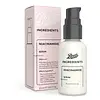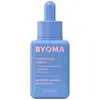What's inside
What's inside
 Key Ingredients
Key Ingredients

 Benefits
Benefits

 Concerns
Concerns

No concerns
 Ingredients Side-by-side
Ingredients Side-by-side

Water
Skin ConditioningGlycerin
HumectantNiacinamide
SmoothingPEG-12 Dimethicone
Skin ConditioningPhenoxyethanol
PreservativePPG-26-Buteth-26
Skin ConditioningAmmonium Acryloyldimethyltaurate/Vp Copolymer
PEG-40 Hydrogenated Castor Oil
EmulsifyingDipotassium Glycyrrhizate
HumectantChlorphenesin
AntimicrobialXanthan Gum
EmulsifyingAloe Barbadensis Leaf Juice
Skin ConditioningBisabolol
MaskingDisodium EDTA
Maltodextrin
AbsorbentPotassium Sorbate
PreservativeSodium Benzoate
MaskingWater, Glycerin, Niacinamide, PEG-12 Dimethicone, Phenoxyethanol, PPG-26-Buteth-26, Ammonium Acryloyldimethyltaurate/Vp Copolymer, PEG-40 Hydrogenated Castor Oil, Dipotassium Glycyrrhizate, Chlorphenesin, Xanthan Gum, Aloe Barbadensis Leaf Juice, Bisabolol, Disodium EDTA, Maltodextrin, Potassium Sorbate, Sodium Benzoate
Water
Skin ConditioningGlycerin
HumectantButylene Glycol
HumectantSqualane
EmollientSodium Stearoyl Glutamate
CleansingAmmonium Acryloyldimethyltaurate/Vp Copolymer
Dipropylene Glycol
HumectantCeramide NP
Skin ConditioningCaprylic/Capric Triglyceride
MaskingCholesterol
EmollientPhytosphingosine
Skin ConditioningStearic Acid
CleansingOleic Acid
EmollientHydroxyacetophenone
AntioxidantPolyglyceryl-4 Oleate
EmulsifyingHydroxyethyl Acrylate/Sodium Acryloyldimethyl Taurate Copolymer
Emulsion StabilisingHydrogenated Lecithin
EmulsifyingCaprylyl Glycol
EmollientGlyceryl Oleate
EmollientLactic Acid
BufferingEthylhexylglycerin
Skin ConditioningHydrogenated Rapeseed Alcohol
EmollientSorbitan Isostearate
EmulsifyingSodium Phytate
Xanthan Gum
EmulsifyingDipotassium Glycyrrhizate
HumectantTocopherol
AntioxidantCaprylhydroxamic Acid
Water, Glycerin, Butylene Glycol, Squalane, Sodium Stearoyl Glutamate, Ammonium Acryloyldimethyltaurate/Vp Copolymer, Dipropylene Glycol, Ceramide NP, Caprylic/Capric Triglyceride, Cholesterol, Phytosphingosine, Stearic Acid, Oleic Acid, Hydroxyacetophenone, Polyglyceryl-4 Oleate, Hydroxyethyl Acrylate/Sodium Acryloyldimethyl Taurate Copolymer, Hydrogenated Lecithin, Caprylyl Glycol, Glyceryl Oleate, Lactic Acid, Ethylhexylglycerin, Hydrogenated Rapeseed Alcohol, Sorbitan Isostearate, Sodium Phytate, Xanthan Gum, Dipotassium Glycyrrhizate, Tocopherol, Caprylhydroxamic Acid
 Reviews
Reviews

Ingredients Explained
These ingredients are found in both products.
Ingredients higher up in an ingredient list are typically present in a larger amount.
Ammonium Acryloyldimethyltaurate/Vp Copolymer (let's call it AAVC for short) is a synthetically created polymer. It's used as a film-forming agent and used to thicken the consistency of products.
AAVC is able to increase the consistency and viscosity of products due to its large molecule size. It also prevents ingredients from separating.
Dipotassium Glycyrrhizate comes from licorice root.
Extracts of licorice have demonstrated to have antibacterial, anti‐inflammatory, antiviral, antioxidant properties.
One component, glabridin, has extra potent antioxidant and soothing properties. It has also been found to block pigmentation from UVB rays in guinea pigs.
Licorice Root also contains a flavonoid. Flavonoids are a natural substance from in plants. Flavonoids also have antioxidant properties.
Another component, glycyrrhizin, has been found to have anti-inflammatory and antimicrobial benefits. This may make licorice root extract effective at treating acne. However, more research is needed to support this.
Liquiritin is one of the flavone compounds found in licorice. It has been found to help lighten skin by preventing tyrosinase from reacting with tyrosine. When the two react, protein is converted to melanin. Melanin is the substance in your body that gives your features pigmentation.
Licorice root is native to Southern Europe and Asia. It has been used in traditional Chinese medicine to help with respiratory issues.
Learn more about Dipotassium GlycyrrhizateGlycerin is already naturally found in your skin. It helps moisturize and protect your skin.
A study from 2016 found glycerin to be more effective as a humectant than AHAs and hyaluronic acid.
As a humectant, it helps the skin stay hydrated by pulling moisture to your skin. The low molecular weight of glycerin allows it to pull moisture into the deeper layers of your skin.
Hydrated skin improves your skin barrier; Your skin barrier helps protect against irritants and bacteria.
Glycerin has also been found to have antimicrobial and antiviral properties. Due to these properties, glycerin is often used in wound and burn treatments.
In cosmetics, glycerin is usually derived from plants such as soybean or palm. However, it can also be sourced from animals, such as tallow or animal fat.
This ingredient is organic, colorless, odorless, and non-toxic.
Glycerin is the name for this ingredient in American English. British English uses Glycerol/Glycerine.
Learn more about GlycerinWater. It's the most common cosmetic ingredient of all. You'll usually see it at the top of ingredient lists, meaning that it makes up the largest part of the product.
So why is it so popular? Water most often acts as a solvent - this means that it helps dissolve other ingredients into the formulation.
You'll also recognize water as that liquid we all need to stay alive. If you see this, drink a glass of water. Stay hydrated!
Learn more about WaterXanthan gum is used as a stabilizer and thickener within cosmetic products. It helps give products a sticky, thick feeling - preventing them from being too runny.
On the technical side of things, xanthan gum is a polysaccharide - a combination consisting of multiple sugar molecules bonded together.
Xanthan gum is a pretty common and great ingredient. It is a natural, non-toxic, non-irritating ingredient that is also commonly used in food products.
Learn more about Xanthan Gum